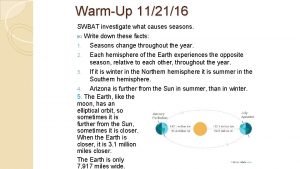Seasonal Change The seasonal change on the Earth




- Slides: 4

Seasonal Change The seasonal change on the Earth occurs due to the tilt of Earth’s axis of rotation relative to the ecliptic, which is the plane of the Earth’s orbit around the Sun. The seasons are not caused by the Earth’s proximity to the Sun. In fact, the Earth is slightly closer to the Sun in the winter than it is in the summer. There are four special points on the Earth’s path around the Sun, which correspond to four special days of the year —the equinoxes and solstices, as shown in the image to the right. During the equinoxes, the Sun is directly overhead at the Equator and the length of day and the length of night are equal everywhere on the Earth. During the June solstice, the Sun’s rays strike directly on the Tropic of Cancer, 23. 5° north of the Equator. The Sun never sets at the North Pole and never rises at the South Pole. During the December solstice, the Sun’s rays shine directly on the Tropic of Capricorn, 23. 5 ° south of the Equator. The Sun never rises at the North Pole and never sets at the South Pole. Solstices and equinoxes. Credit: National Weather Service Knowledge Cards

Sun Path The previous image about solstices and equinoxes shows the relation between the Sun and the Earth as celestial bodies. The Sun path, on the other hand, shows the trajectory of the Sun relative to a location on the Earth during a day and throughout a year. In other words, the Sun path represents the motion of the Sun that an observer on the Earth perceives. Summer Except for the polar regions, the Sun always rises from the East and sets to the West. The difference is the height it appears to be at in the sky in different seasons. In the summer, the Sun is high in the sky. Whereas in the winter, the Sun is low in the sky. The image to the right, which was taken using longexposure pinhole photography, captures the Sun’s path for an entire year. Why is the Sun path important? The Sun path determines the length of daytime and the amount of daylight received along a certain latitude on a given day. A longer path leads to a longer day and a higher position results in stronger direct solar radiation. The relative position of the Sun is a major factor in the heat gain of buildings and in the performance of solar energy systems. West Winter East Solargraphy captures the Sun path across the sky throughout the year of 2014 in Budapest. Credit : Elekes Andor Knowledge Cards

Daytime Length Due to the seasonal change of the Sun path, we experience longer days in the summer than in the winter, as shown in the image to the right. But did you know that the day is actually longer in Boston (MA) than in Miami (FL) in the summer? This knowledge may be important for designing good engineering solutions that harness solar energy in the two areas effectively. Daytime refers to the time between sunrise and sunset during which a place on the Earth is illuminated by the Sun. The length of daytime depends on the time of the year and the latitude of the location. It is interesting to note that the polar regions are continuously illuminated by the Sun 24 hours in the summer. Note that daytime length is different from sunshine duration in which the Sun is clearly visible (e. g. , in a cloudless sky). The sunshine duration cannot be longer than the daytime length, but is in general proportional to the daytime length. The output of a solar energy system is determined by the sunshine hours. The daytime length varies from season to season as the Sun path changes. Knowledge Cards

Projection Effect Sun beam n Su m a be θ Surface The projection effect on a horizontal surface. The sizes of the dashed areas represent the amounts of solar radiation the surface receives at the two angles. Knowledge Cards







